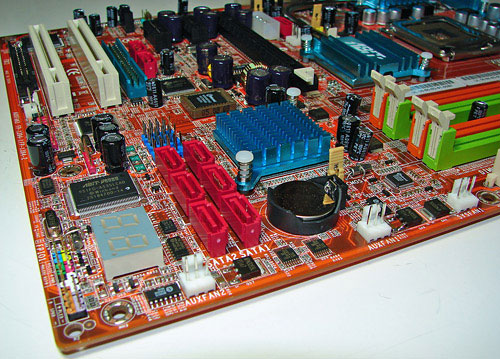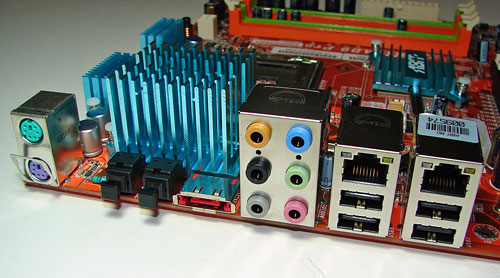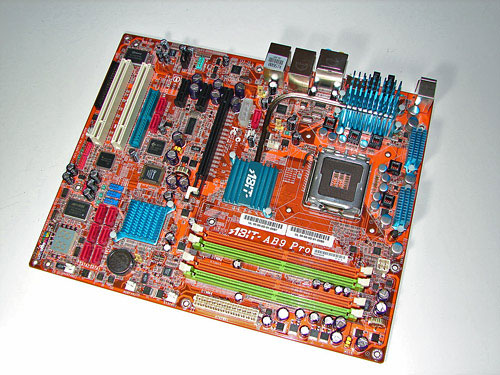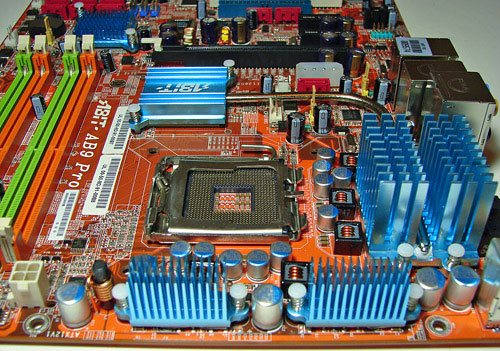Abit AB9 Pro: A sneak peek at Intel's new P965 chipset
by Gary Key on July 3, 2006 3:45 AM EST- Posted in
- Motherboards
Board Layout and Features
Abit designed a board that has one of the more interesting layouts we have seen in our labs in a long time. While the board was very easy to install in our mid-size ATX case, we did have some issues with utilizing our optical drive in the top bay due to the location of the JMicron powered IDE port that is located in between the number two PCI Express X1 slot and the number one PCI slot. The Abit board features an excellent voltage regulator power design with high quality capacitors located in each major component section of the board that yielded superb stability with our early BIOS revisions. Our board was able to POST our 805D at 4660MHz but we could not enter Windows due to the inability to change memory timings with the current BIOS. We certainly foresee this board being excellent at overclocking if the BIOS matures properly.
The DIMM module slots' color coordination is correct for dual channel setup based upon the premise of utilizing different colors for each memory bank. The memory modules are easy to install with a full size video card placed in the first PCI Express X16 slot. The 24-pin ATX power connector is located along the edge of the board along with a series of capacitors for the memory modules. Abit places the four-pin 12v auxiliary power connector at the top of the first memory module but completely out of the way of aftermarket cooling solutions.

The six Intel ICH8R SATA ports are color coded red and are located to the left of the ICH8R Southbridge and battery. The SATA ports feature the newer clamp and latch design. We found the positioning of the SATA ports to be excellent when utilizing either the PCI-E X1 or PCI 2.3 slots. The ICH8R is passively cooled and remained cool to the touch throughout testing.
The first three of five auxiliary fan connectors are located at the bottom edge of the board. The clear CMOS jumper is color coded yellow and is located in between the battery and ICH8R chipset. The CP80P POST port debug LED, chassis panel, µGuru chipset, and red 1394a connectors are located along the left edge of the board. The blue USB 2.0 connectors are located above the SATA ports.

The board comes with one physical PCI Express X16 connector, two PCI Express X1 connectors, and two PCI 2.3 connectors. The layout of this design offers a very good balance of expansion slots for a mainstream board while providing excellent clearance space for graphics card utilization. However, the layout in this area is very unusual if not a bit chaotic. Our main issue is the location of the floppy drive connector at the bottom of the board along with the JMicron JMB363 IDE and SATA ports being sandwiched in between the PCI-E and PCI slots in the middle of the board.
The four-pin molex power connector that will be required for future GPU products and the Silicon Image 3132 SATA port is located above the PCI-E X16 slot. The P965 chipset will not officially support CrossFire or SLI operation so the lack of a secondary PCI-E X16 slot means this board could have been arranged differently. However, Abit informed us that some of the unusual port locations were predicated upon ensuring proper power delivery, stability, and trace layouts based upon the capacitor locations. That may be true, but we think they would do better to add more capacitors and do whatever else is necessary to accommodate a more ideal layout, as frankly the current layout really isn't what we'd like to see.
Returning to the CPU socket area, we find an ample amount of room for alternative cooling solutions. We utilized the stock heatsink/fan in our normal testing but also verified a couple of larger Socket-775 cooling solutions would fit in this area during our overclocking tests.
The Intel P965 MCH chipset is passively cooled with a low rise heatsink unit that did not interfere with any installed peripherals. This heatsink is part of the Abit Silent OTES technology that includes a heatpipe system and additional passive cooling for the VRM components. This system kept the MCH cool enough that additional chipset voltage was not a factor in our overclocking tests.

The rear panel contains the standard PS/2 mouse and keyboard ports, LAN ports, and 4 USB ports. The LAN (RJ-45) ports have two LED indicators representing Activity and Speed of the connection through the Realtek RTL8111B Gigabit PCI-E chipset. The audio panel consists of 6 ports that can be configured for 2, 4, 6, and 8-channel audio connections for the Realtek ALC 882D HD codec. The panel includes two S/PDIF (optical in/optical out) ports, and an external SATA 3Gb/s port via the Silicon Image 3132 chipset.
 |
| Click to enlarge |
Abit designed a board that has one of the more interesting layouts we have seen in our labs in a long time. While the board was very easy to install in our mid-size ATX case, we did have some issues with utilizing our optical drive in the top bay due to the location of the JMicron powered IDE port that is located in between the number two PCI Express X1 slot and the number one PCI slot. The Abit board features an excellent voltage regulator power design with high quality capacitors located in each major component section of the board that yielded superb stability with our early BIOS revisions. Our board was able to POST our 805D at 4660MHz but we could not enter Windows due to the inability to change memory timings with the current BIOS. We certainly foresee this board being excellent at overclocking if the BIOS matures properly.
 |
| Click to enlarge |
The DIMM module slots' color coordination is correct for dual channel setup based upon the premise of utilizing different colors for each memory bank. The memory modules are easy to install with a full size video card placed in the first PCI Express X16 slot. The 24-pin ATX power connector is located along the edge of the board along with a series of capacitors for the memory modules. Abit places the four-pin 12v auxiliary power connector at the top of the first memory module but completely out of the way of aftermarket cooling solutions.

The six Intel ICH8R SATA ports are color coded red and are located to the left of the ICH8R Southbridge and battery. The SATA ports feature the newer clamp and latch design. We found the positioning of the SATA ports to be excellent when utilizing either the PCI-E X1 or PCI 2.3 slots. The ICH8R is passively cooled and remained cool to the touch throughout testing.
The first three of five auxiliary fan connectors are located at the bottom edge of the board. The clear CMOS jumper is color coded yellow and is located in between the battery and ICH8R chipset. The CP80P POST port debug LED, chassis panel, µGuru chipset, and red 1394a connectors are located along the left edge of the board. The blue USB 2.0 connectors are located above the SATA ports.

The board comes with one physical PCI Express X16 connector, two PCI Express X1 connectors, and two PCI 2.3 connectors. The layout of this design offers a very good balance of expansion slots for a mainstream board while providing excellent clearance space for graphics card utilization. However, the layout in this area is very unusual if not a bit chaotic. Our main issue is the location of the floppy drive connector at the bottom of the board along with the JMicron JMB363 IDE and SATA ports being sandwiched in between the PCI-E and PCI slots in the middle of the board.
The four-pin molex power connector that will be required for future GPU products and the Silicon Image 3132 SATA port is located above the PCI-E X16 slot. The P965 chipset will not officially support CrossFire or SLI operation so the lack of a secondary PCI-E X16 slot means this board could have been arranged differently. However, Abit informed us that some of the unusual port locations were predicated upon ensuring proper power delivery, stability, and trace layouts based upon the capacitor locations. That may be true, but we think they would do better to add more capacitors and do whatever else is necessary to accommodate a more ideal layout, as frankly the current layout really isn't what we'd like to see.
 |
| Click to enlarge |
Returning to the CPU socket area, we find an ample amount of room for alternative cooling solutions. We utilized the stock heatsink/fan in our normal testing but also verified a couple of larger Socket-775 cooling solutions would fit in this area during our overclocking tests.
The Intel P965 MCH chipset is passively cooled with a low rise heatsink unit that did not interfere with any installed peripherals. This heatsink is part of the Abit Silent OTES technology that includes a heatpipe system and additional passive cooling for the VRM components. This system kept the MCH cool enough that additional chipset voltage was not a factor in our overclocking tests.

The rear panel contains the standard PS/2 mouse and keyboard ports, LAN ports, and 4 USB ports. The LAN (RJ-45) ports have two LED indicators representing Activity and Speed of the connection through the Realtek RTL8111B Gigabit PCI-E chipset. The audio panel consists of 6 ports that can be configured for 2, 4, 6, and 8-channel audio connections for the Realtek ALC 882D HD codec. The panel includes two S/PDIF (optical in/optical out) ports, and an external SATA 3Gb/s port via the Silicon Image 3132 chipset.










33 Comments
View All Comments
mechBgon - Thursday, July 6, 2006 - link
Peak. A summit, a maximum value, etc.Peek. A quick look, a glance.
Pique. Annoyance, such as some people experience when "peak" and "peek" get swapped in full view of 2-3 million people. ;)
That is all. We now return you to your regularly-scheduled DailyTech program. :)7
JarredWalton - Saturday, July 8, 2006 - link
It just looked so nice right next to "sneak". We were debating between a "sneek peek", a "sneak peak", and a "snique pique" and you can see which one got the vote. ;)Sorry for the error - proofing thousands of words per week, stuff does slip through occasionally. On the bright side, we can fix the errors as they're caught - revisionist publishing at its best.
zsdersw - Thursday, July 6, 2006 - link
Pique can also mean to provoke or arouse.. as in: "His flashy outfit piqued my interest."commonuser - Thursday, July 6, 2006 - link
good review. particularly so as i've become increasingly interested in the direction these new platforms will take.however, i must say that i'm finding the obsession with SLI/Crossfire a bit overemphasized in every motherboard review i've read on the web as of late. now, i really do not have the exact figures at my disposal, but i'd say with a pretty high level of assumptive confidence that a significantly lower proportion of so-called "enthusiast" cyberpopulace makes use of these solutions, compared to traditional, albeit powerful single-gpu setup (think x1900xtx, or 7900gtx). "mainstream" segment falls into a non-SLI/CF category even more so...
therefore, when we have this opening sentence: , and this sentence in the conclusion: , one has to ask him/herself: what really is the difference among "enthusiast", "mainstream", "value", and/or "entry-level" chipsets and mainboards? is it soon going to be a huge oversight or a mistake if a manufacturer leaves out SLI support on a "value" or "entry-level" MB?
JarredWalton - Saturday, July 8, 2006 - link
Note the criticism is directed at *Intel* for not allowing manufacturers to make 2x8 PCIe configurations using P965. Given the cost of making that change, I would much rather have the option of using SLI/CF even if I never take advantage of it. One PCIe X16 slot is pretty much "value oriented" in my opinion these days.Kiste - Thursday, July 6, 2006 - link
Is it even possible to install WinXP from a PATA drive if the PATA port is 3rd party?I just bought a very nice BenQ PATA DVD writer and I certainly won't get rid of it just to buy Plextor's crappy SATA DVD writer or the even more abysmal one from Samsung.
Gary Key - Thursday, July 6, 2006 - link
Yes, there is limited functionality in the bios that allows the system to recognize the PATA port upon boot and for it to be utilized to load the OS or drivers if the OS is already loaded. We have seen this operation on our first two 965 boards but have one board that would not allow the PATA port to be recognized until the drivers were loaded. We were told this would be corrected in the shipping bios.goinginstyle - Tuesday, July 11, 2006 - link
Is it possible to load Linux with this IDE controller?Kiste - Thursday, July 6, 2006 - link
Ok, I'm not sure I completely understand. I can boot up with my WinXP installation CD and then I'll have to install drivers for the 3rd party PATA controller before I can install WinXP? Is that about right? Does that mean that I need a floppy drive?JarredWalton - Saturday, July 8, 2006 - link
If the BIOS is designed correctly, it can make the base XP installation detect the 3rd party IDE without drivers. Some earlier IDE chipsets didn't work (back in nF3 and ealier time frame), but most IDE and SATA solutions will now work without a driver disk. You would still need the driver disk for RAID, and certain BIOS settings might require it as well.